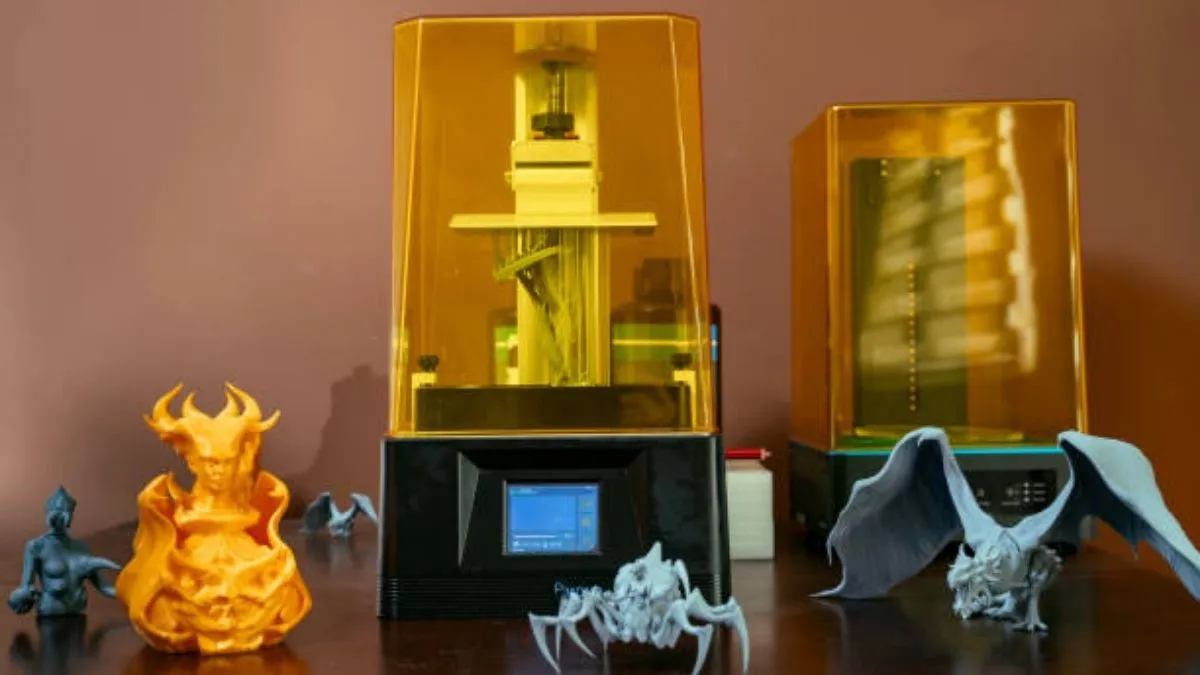GENERAL
Are Resin 3D Printers Better?

When asking whether resin 3D printers are better, the most honest answer is: it depends entirely on what you want to make. Think of it like choosing between a paintbrush and a can of spray paint—one isn’t “better,” they’re just designed for different jobs. This guide will cut through the noise and help you decide which is right for you.
For creating objects with breathtaking detail and a smooth, professional finish—like tabletop miniatures or intricate jewelry—a resin 3D printer is unbeatable.
However, for larger, more durable functional parts, prototypes, and general hobbyist projects where cost and strength are top priorities, a filament (FDM) printer is the superior choice.
Table of Contents
Resin vs. Filament
For those who want the key takeaways right away, here’s a simple breakdown of the resin vs filament 3D printer debate.
| Feature | Resin (SLA/MSLA) | Filament (FDM) |
| Best For | Intricate details, miniatures, smooth surfaces | Functional parts, large prints, prototyping |
| Print Resolution | Extremely High (up to 0.025 mm) | Good to High (typically 0.1 mm) |
| Surface Finish | Very Smooth | Visible Layer Lines |
| Print Strength | Generally brittle (but tough resins exist) | Strong and durable (PLA, PETG, ABS) |
| Ease of Use | Steeper learning curve, messy post-processing | More beginner-friendly |
| Ongoing Costs | Higher (resin & cleaning supplies) | Lower (filament is cheaper) |
| Safety & Handling | Requires gloves, ventilation, and care | Generally safe, minimal fumes with PLA |
How Do They Actually Work?
Understanding the fundamental difference between these technologies is key to knowing why they produce such different results. Let’s keep it simple.
Resin Printers: Curing Liquid with Light
A resin 3D printer, which uses a technology often called SLA or MSLA, works by starting with a tank (or “vat”) of liquid photopolymer resin.
A UV light source from below shines a specific shape through the transparent bottom of the vat. The light instantly hardens the liquid resin it touches, forming a solid layer. The build plate then lifts up slightly, and the process repeats, layer by layer, until your object is complete.
Analogy: Imagine building something out of a special liquid that instantly turns solid wherever a flashlight beam hits it.
Filament Printers: Drawing with Melted Plastic
Filament printers use a technology called Fused Deposition Modeling (FDM). This is the type of 3D printing most people picture.
A solid spool of plastic, called filament, is fed into a hot nozzle on the printer’s print head. The nozzle melts the plastic and extrudes it onto a build plate, essentially drawing the object one layer at a time from the bottom up.
Analogy: It’s like a very precise, computer-controlled hot glue gun building an object from scratch.
A Detailed Resin vs. FDM Breakdown
Now let’s dive into the specifics. In the direct comparison of FDM vs SLA, which one comes out on top in the categories that matter most?
Resin 3D Printing Achieves Exceptional Detail
There is no contest here. Resin printers produce details on a microscopic level because the resolution is determined by the pixel size of the UV light source. This results in an incredibly smooth surface finish that looks almost like an injection-molded part, with no visible layer lines.
This makes them the perfect 3D printer for miniatures, jewelry, and detailed character models where every tiny feature matters. FDM printers, while capable, will always show faint layer lines and cannot capture the same level of fine detail.
Filament Prints Provide Superior Strength
If you need to make strong 3D prints for functional use—like a replacement part for an appliance, a custom tool, or a robotics project—filament is your champion.
Common FDM materials like PETG and ABS are thermoplastics renowned for their toughness, temperature resistance, and ability to withstand impact. Standard resins, by contrast, are often quite brittle and can shatter if dropped. While stronger “engineering” resins exist, they are significantly more expensive, making FDM the practical and cost-effective choice for durable parts.
FDM Printing is More Budget-Friendly
While the initial cost of entry-level resin and FDM printers has become very similar, the ongoing operational cost is a different story.
- FDM: A 1kg spool of quality PLA filament typically costs between $20 and $25.
- Resin: A 1kg (or 1-liter) bottle of standard resin usually costs between $30 and $50.
Furthermore, resin printing has hidden costs. You’ll constantly need to buy disposable gloves, paper towels, and large quantities of Isopropyl Alcohol (IPA) or another cleaner for washing parts. For budget-conscious printing, FDM wins easily.
FDM 3D Printer Offers a Smoother Start
For someone just starting their 3D printing journey, FDM is undeniably simpler and less intimidating. The workflow is straightforward: load the filament, level the bed, and hit print. Post-processing usually just involves snapping off a few support structures.
In contrast, the resin printer post-processing workflow is a mandatory, multi-step procedure:
- Wear Gloves & Mask: Resin and its fumes can be toxic.
- Wash the Print: The finished print must be thoroughly washed in IPA to remove uncured liquid resin.
- Cure the Print: The washed print then needs to be exposed to UV light in a curing station to achieve its final hardness and strength.
This process is messy, requires a dedicated, well-ventilated space, and involves handling chemicals. This makes FDM the best 3D printer for beginners.
Winner for Material Variety & Applications
This category is interesting because both printer types offer a wide range of materials, but for very different purposes.
- FDM Materials: Offer incredible functional variety. You can print with standard plastics like PLA, strong materials like PETG/ABS, flexible rubber-like materials (TPU), and even composites filled with wood, carbon fiber, or metal particles.
- Resin Materials: Offer incredible specialized precision. You can get standard resins, tough/ABS-like resins for better durability, flexible resins, castable resins that burn away cleanly (perfect for jewelry casting), and even biocompatible resins for dental applications.
It’s a tie: FDM wins for general-purpose variety, while resin wins for highly specialized, high-detail applications.
Who Should Buy a Resin 3D Printer?
You should choose a resin 3D printer if you are a:
- Miniature Painter or Tabletop Gamer: For creating incredibly detailed figures, monsters, and terrain that are a joy to paint.
- Jewelry Designer: For crafting intricate master patterns for metal casting.
- Engineer or Product Designer: For making high-fidelity prototypes that require a smooth, consumer-ready surface finish.
- Artist or Sculptor: For bringing complex digital sculptures to life with perfect accuracy.
Who Should Buy a Filament 3D Printer?
You should choose a filament printer if you are a:
- Hobbyist or Tinkerer: For printing custom tools, workshop gadgets, and useful items for around the house.
- Prototyper: For quickly and cheaply creating functional parts to test form, fit, and mechanics.
- Cosplayer: For making large-scale armor pieces, props, and helmets that need to be durable and lightweight.
- Beginner or Parent: For the most straightforward, affordable, and safest entry point into the world of 3D printing.
Which 3D Printer is Better for You?
So, back to the original question: are resin 3D printers better? No. Are filament printers better? Also no. The best printer is the one that best serves your creative goals.
The choice boils down to a single core trade-off:
You are choosing between Detail & Finish (Resin) and Strength, Size, & Simplicity (Filament).
Look at the projects you dream of creating. If they involve tiny, intricate details, choose resin. If they involve functional, strong, or large objects, choose filament. For many serious makers, the answer is eventually having one of each. But for your first, pick the one that will bring your most immediate ideas to life.
FAQs
Are resin 3D printers messy?
Yes, the process involves liquid chemicals and requires a dedicated, well-ventilated workspace and a mandatory cleaning process after every print.
Are resin prints strong?
Standard resin prints are brittle. While stronger engineering resins are available, FDM prints made from materials like PETG or ABS are generally more durable and impact-resistant for functional applications.
Can you have a resin printer in your room?
It is strongly advised not to. Resin printers produce fumes (VOCs) that require proper ventilation, such as an open window with a fan or a dedicated enclosure vented outside.
-

 GENERAL5 months ago
GENERAL5 months agoChristofle – For Those Who Dream of Family Heirloom Silver
-

 SPORTS7 months ago
SPORTS7 months agoDiscover the World of Football with Streameast: Watch Your Favorite Leagues and Tournaments
-

 GENERAL4 months ago
GENERAL4 months agoUncovering the World of кинокрадко: The Dark Side of Film Piracy
-

 GENERAL2 months ago
GENERAL2 months agoATFBooru: Anime, Gaming, and Subculture Imageboard























